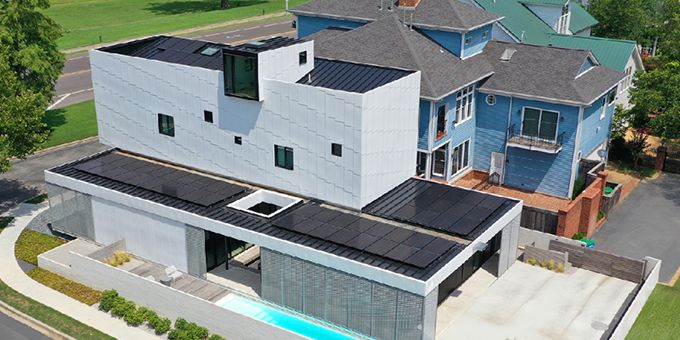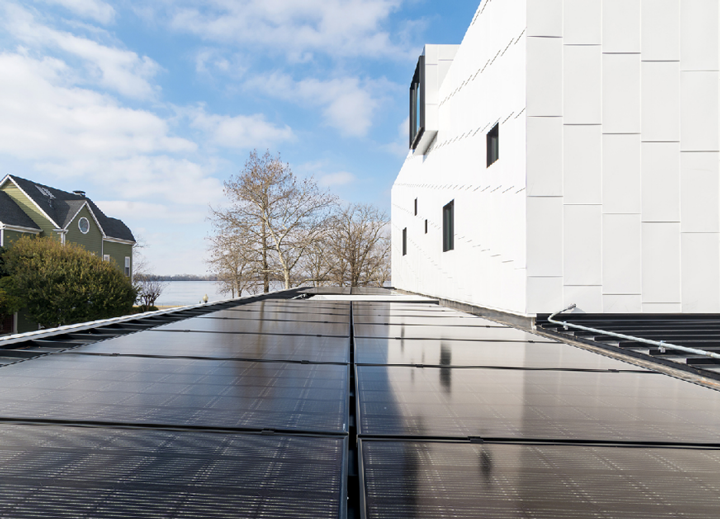Located in Memphis on the banks of the Mississippi River, the civitas home project is a 2,800-square-foot residence that aims to be one of the first homes in America to be certified Zero Emissions, Zero Energy, and Reveal, along with attaining LEED Platinum certification.
 Solar Energy Powers ‘Home of the Future’
Solar Energy Powers ‘Home of the Future’

Case Study from | LG SOLAR RESIDENTIAL
CHALLENGE
With the need to curb greenhouse gas emissions, many companies large and small are eagerly blazing a path forward with innovative solutions that can have very substantial environmental impacts. One forward-thinking architectural firm, archimania in Memphis, Tenn., is taking this challenge head-on in the residential space with the design and construction of civitas, a reimagining of what the home of the future can be with green technologies fully implemented.
Located in Memphis on the banks of the Mississippi River, the civitas home project is a 2,800-square-foot residence that aims to be one of the first homes in America to be certified Zero Emissions, Zero Energy, and Reveal (AIA2030 Challenge), along with attaining LEED Platinum certification. It features two primary rectangular, flat-roofed forms, using structural insulated panels and cross-laminated timber for the first time, all clad in recycled aluminum and floor-to-ceiling, operable glass that easily opens to bring fresh air into the home.
The green design and building experts at archimania wanted to create a carbon-neutral solution for hot, humid climates that utilizes solar panels to power the home and reduce the carbon footprint. The goal of the civitas project—designed and owned by Barry Alan Yoakum, FAIA, archimania’s principal—is to inspire the development of other carbon neutral and environmentally-conscious residential dwellings to help curb the effects of climate change in local communities. The civitas structure is informed by the typology of a southern dogtrot style home with the infusion of 21st-century finishes and technology for the house to become zero carbon, zero energy.
CRITERIA
It was paramount for archimania to select the right solar module partner in order to achieve its aggressive goal of being a carbon neutral home of the future. With the project demanding cutting-edge technology that could deliver zero emissions, zero energy and LEED Platinum certification, the team needed an innovative solar partner that could provide connectivity between the solar panels and energy storage system, increase efficiency, and still present the desired aesthetic appeal with a lightweight panel attached securely to the roof.

SOLUTION
After an audit of the landscape, the archimania team, led by local installer LightWave Solar selected solar panel innovator LG Electronics for its ability to fulfill each of the requirements outlined for the project. Interestingly enough, LG just announced its own plans for the company to achieve carbon neutral status by 2030. For civitas, LightWave Solar designed an efficient solution that would allow for an aesthetically-appealing look on the home’s roof and easily connect to the planned battery storage system.
After carefully reviewing the requirements, LightWave specified the LG NeON® 2 320W solar panel, known for its incredible energy efficiency, high performance and sleek aesthetics. The NeON 2 solar panels incorporate LG’s innovative Cello™ technology which utilizes 12 thin wires instead of three busbars, offering significantly improved performance and reliability. The end result was 59 LG panels installed on the roof of the home.
Complementing the high-efficiency LG solar panels, LightWave installed a SolarEdge StorEdge inverter and a Residential Energy Storage Unit (RESU) battery from LG Electronics sister company LG Chem. The battery storage system can store excess energy during the day to be used after the sun goes down when the family is home and electricity consumption increases.
RESULTS
Thanks in large part to LG’s efficient solar panels, the civitas home project is well on its way to meeting its carbon neutral goals, as it nears completion.
“With civitas, we want to demonstrate that a home can be free of utility bills while having a positive environmental impact and connection with nature. LG’s the perfect partner to help, as they deliver every single time,” says Yoakum. “Incredibly, the LG panels gave us the capabilities to meet all the demands as we were navigating the complicated installation process. The system will shine in providing minimal routine maintenance, low operating cost and significant energy savings. We felt confident with the performance of the NeON 2 panels delivering the desired output, plus LG’s strong warranty pushed us over the edge into this partnership.”
In addition to delivering on the energy-efficiency requirements, the LG NeON 2 solution complemented the architectural features of the home. The solar panels are all black, which matches the home’s black metal roof, explains Chris Koczaja, president of LightWave Solar. “The all-black, high-efficiency panels allowed us to easily incorporate the panels onto the roof and complement the look and feel of the home’s high-end aesthetic.” he says.
Altogether, archimania estimates that the home’s 15kW of solar capacity will reduce carbon dioxide emissions equal to growing 13 acres of forest, while also preventing the generation of nearly 2,500 pounds of harmful coal ash every year. This amount of green energy, powered by LG Solar, is putting the home on the path toward its goal of being carbon neutral.
The content & opinions in this article are the author’s and do not necessarily represent the views of AltEnergyMag
Comments (1)
Featured Product

